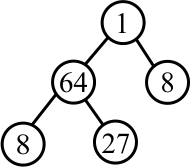
The following types are suitable for representing a tree that has an integer stored at each node. An object of type Node represents one node in a binary tree. It holds an integer item, a pointer to the left subtree and a pointer to the right subtree. Those pointers can be NULL to indicate an empty subtree.
Note that type Tree is identical to type Node*. An empty tree is represented by a NULL pointer.
struct Node
{
int item; // Information at this node
Node* left; // The left subtree
Node* right; // The right subtree
Node(int it, Node* lft, Node* rgt)
{
item = it;
left = lft;
right = rgt;
}
};
typedef Node* Tree;
typedef const Node* ConstTree;
As for linked lists, we can separate functions on trees into nondestructive functions, which do not alter a tree, and destructive functions, which do.
A simple nondestructive function is numNodes(T ), which yields the number of nodes in tree T. The algorithm breaks down naturally into two cases: an empty tree (NULL) and a nonempty tree.
If T is empty then T has 0 nodes.
If T is nonempty then T has its root (one node) plus all of the nodes in the left subtree plus all of the nodes in the right subtree.
Putting those ideas into a definition of numNodes(T ) yields the following.
int numNodes(ConstTree T)
{
if(T == NULL)
{
return 0;
}
else
{
return 1 + numNodes(T->left) + numNodes(T->right);
}
}
Another example of a nondestructive function on trees is cubes(T ), which returns a tree that looks like T except that each number is replaced by its cube. For example, if T is

then cubes(T ) yields the following tree, without modifying T.

int cube(int x)
{
return x*x*x;
}
Tree cubes(ConstTree T)
{
if(T == NULL)
{
return NULL;
}
else
{
return new Node(cube(T->item), cubes(T->left), cubes(T->right));
}
}
A destructive function modifies a tree. For example, the following function replaces each item in a tree by its cube.
void cubeAll(Tree T)
{
if(T != NULL)
{
T->item = cube(T->item);
cubeAll(T->left);
cubeAll(T->right);
}
}
Note that T does not need to be passed by
reference to cubeAll
because cubeAll does not need to change the pointer T. It only changes the node to
which T points (and other nodes in subtrees). So cubeAll uses
call by pointer.
But some functions do need to use call by reference,
since they need to store a different pointer into a variable.
We will see some examples of that shortly.
Write a definition of function numLeaves(T ), which returns the number of leaves in tree T. Answer
Write a definition of a function sum(T ) that returns the sum of all of the numbers in a given tree. If T is empty then sum(T ) is 0. Answer
Write a definition of function nonneg(T ), which produces the tree that results by replacing each negative number in T by 0, and leaves nonnegative numbers as they were. For example, if T is the left-hand tree below then nonneg(T ) is the right-hand tree.

This function must not modify T. The result tree should be made out of new nodes.
AnswerWrite a definition of function mirror(T ), which produces a mirror image of tree T. To get the mirror image, imagine picking the tree up with a spatula and flipping it over. For example, the following two trees are mirror images of one another.

This function must not modify T. The result tree should be made out of new nodes.
AnswerRead the definition of the height of a tree. Write a function height(T ) that returns the height of tree T. Answer
The mirror image of a tree is defined in question 4. Write a definition of function flip(T ) that changes T into its mirror image. This is a destructive function. Answer
Why doesn't the parameter of flip in the preceding question need to be passed by reference? Answer
Write a definition of function destroy(T ), which deletes every node in tree T. Answer